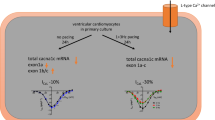Abstract
The α1c subunit (DHP receptor) of the L-type Ca2+ channel is important for calcium homeostasis in cardiac muscle. The DHPr provides the primary mechanism for calcium influx during contraction. Published results demonstrate three in vitro signaling pathways that are important in the regulation of DHPr gene expression in neonatal cardiac myocytes, the protein kinase A (PKA), protein kinase C (PKC) pathways, and intracellular calcium. To determine whether these pathways are important in vivo, we treated adult rats with infusions of isoproterenol, or norepinephrine at 200 μg/kg/h and assessed DHPr mRNA and protein levels. Following a 3-day infusion isoproterenol (ISO) and norepinephrine (NE) produced a small but insignificant reduction in DHPr mRNA levels. When the infusions were continued for 7 days isoproterenol increased DHPr mRNA accumulation to control levels while NE stimulated a 35% increase in DHPr mRNA levels and a 35% increase in protein abundance when compared to controls (p < 0.05). Furthermore, contractility and Ca2+ transient measurements of isolated cardiac myocytes from NE infused animals also display shortened duration of contraction/relaxation and increased intracellular free Ca2+ (DFFI) in response to electrical stimulation (p < 0.01). We conclude norepinephrine treatment alters DHPr mRNA and protein levels, and augments excitation-contraction coupling, and thus may be important for modulating cardiac calcium homeostasis in vivo.
Similar content being viewed by others
References
Singer D, Biel M, Llotan I, Flockerzi V, Hofmann F, Dascal N: The roles of the subunits in the function of the calcium channel. Science 253: 1553–1557, 1991
Wei XY, Perez-Reyes E, Lacerda AE, Schuster G, Brown AM, Birnbaumer L: Heterologous regulation of the cardiac Ca2+ channel alpha 1 subunit by skeletal muscle beta and gamma subunits. Implications for the structure of cardiac L-type Ca2+ channels. J Biol Chem 266: 21943–21947, 1991
Maki T, Gruver EJ, Davidoff AJ, Izzo N, Toupin D, Colucci W, Marks AR, Marsh JD: Regulation of calcium channel expression in neonatal myocytes by catecholamines. J Clin Invest 97: 656–663, 1996
Golden KL, Fan QI, Chen B, Ren J, O'Connor JA, Marsh JD: Adrenergic stimulation regulates Na/Ca exchanger expression in rat cardiac myocytes. J Mol Cell Cardiol 32: 611–620, 2000
Golden KL, Ren J, O'Connor JA J, Dean A, Dicarlo SE, Marsh JD: In vivo regulation of Na/Ca exchanger expression by adrenergic effectors. Am J Physiol 280: H1376–H1382, 2001
Chomczynski P, Sacchi N. Single-step method of RNA isolation by acid guanidium thiocyanate-phenol-chloroform extraction. Anal Biochem 162: 156–159, 1987
Ren J, Davidoff AJ: Diabetes rapidly induces contractile dysfunctions in isolated ventricular myocytes. Am J Physiol 272: H148–H158, 1997
Bers DM, Berlin JR: Kinetics of [Ca2+]i decline in cardiac myocytes depend on peak [Ca2+]i. Am J Physiol 268: C271–C277, 1995
Abdelrahman A, Pang CC: Differential venous effects of isoprenaline in conscious rats. Eur J Pharmcol 190: 321–327, 1990
Keung DC: Calcium current is increased in isolated adult myocytes from hypertrophied rat myocardium. Circ Res 64: 753–763, 1989
Scamps F, Mayoux E, Charlemange D, Vassort G: Calcium current in single cells isolated from normal and hypertrophied rat heart. Circ Res 67: 199–208, 1990
Gómez AM, Valdivia HH, Cheng H, Lederer MR, Santana LF, Cannell MB, McCune SA, Altschuld RA, Lederer WJ: Defective excitationcontraction coupling in experimental cardiac hypertrophy and heart failure. Science 276: 800–806, 1997
Richard S, Leclerq F, Lemaire S, Piot C, Nargeot J: Ca2+ currents in compensated hypertrophy and heart failure. Cardiovasc Res 37: 300–311, 1998
Xiao YF, Mcardle JJ: Elevated density and altered pharmacologic properties of myocardial calcium current of the spontaneously hypertensive rat. J Hypertens 12:783–789, 1994
Ryder KO, Bryant SM, Hart G: Membrane current changes in left ventricular myocytes isolated from guinea pigs after abdominal aortic coarctation. Cardiovasc Res 27: 1278–87, 1993
Kleinman RB, Houser SR: Calcium currents in normal and hypertrophied isolated feline ventricular myocytes. Am J Physiol 255: H1434–H1442, 1988
Beuckelmann DJ, Nabauer M, Erdmann E: Intracellular calcium handling in isolated ventricular myocytes from patients with terminal heart failure. Circulation 3: 1046–1055, 1992
Nuss HB, Houser SR: T-type Ca2+ current is expressed in hypertrophied adult feline left ventricular myocytes. Circ Res 73: 777–782, 1993
Boixel C, Tessier S, Pansard Y, Lang-Lazdunski L, Mercadier JJ, Hatem SN: Tyrosine kinase and protein kinase C regulate L-type Ca(2+) current cooperatively in human atrial myocytes. Am J Physiol 278: H670–H676, 2000
Boutjdir M, Restivo M, Wei Y, El-Sherif N: Alpha 1–and beta-adrenergic interactions on L-type calcium current in cardiac myocytes. Pflügers Arch 421: 397–399, 1992
Whitmarsh AJ, Davis RJ: Transcription factor AP-1 regulation by mitogen-activated protein kinase signal transduction pathways. J Mol Med 74: 589–607, 1996
Liu L, Fan QI, El-Zaru MR, Vanderpool K, Hines RN, Marsh JD: Regulation of DHP receptor expression by elements in the 5′-flanking sequence. Am J Physiol 278: H1153–H1162, 2000
Gengo PJ, Bowling N, Wyss VL, Hayes JS: Effects of prolonged phenylephrine infusion on cardiac adrenoceptors and calcium channels. J Pharmacol Exp Ther 244: 100–105, 1988
Siri FM, Krueger J, Nordin C, Ming Z, Aronson RS: Depressed intracellular calcium transients and contraction in myocytes from hypertrophied and failing guinea pig hearts. Am J Physiol 261: H514–H530, 1991
Bing OH, Brooks WW, Conrad CH, Sen S, Perreault CL, Morgan JP: Intracellular calcium transients in myocardium from spontaneously hypertensive rats during the transition to heart failure. Circ Res 68: 1390–400, 1991
Shorofsky SR, Aggarwal R, Corretti M, Baffa JM, Strum JM, Al-Seikhan BA, Kobayashi YM, Jones LR, Wier WG, Balke CW: Cellular mechanisms of altered contractility in the hypertrophied heart: Big hearts, big sparks. Circ Res 84: 424–434, 1999
Liang CS, Sherman LG, Doherty JU, Wellington K, Lee VW, Hood WB: Sustained improvement of cardiac function in patients with congestive heart failure after short-term infusion of dobutamine. Circulation 69: 113–119, 1984
Author information
Authors and Affiliations
Rights and permissions
About this article
Cite this article
Golden, K.L., Ren, J., Dean, A. et al. Norepinephrine regulates the in vivo expression of the L-type calcium channel. Mol Cell Biochem 236, 107–114 (2002). https://doi.org/10.1023/A:1016112617817
Issue Date:
DOI: https://doi.org/10.1023/A:1016112617817




